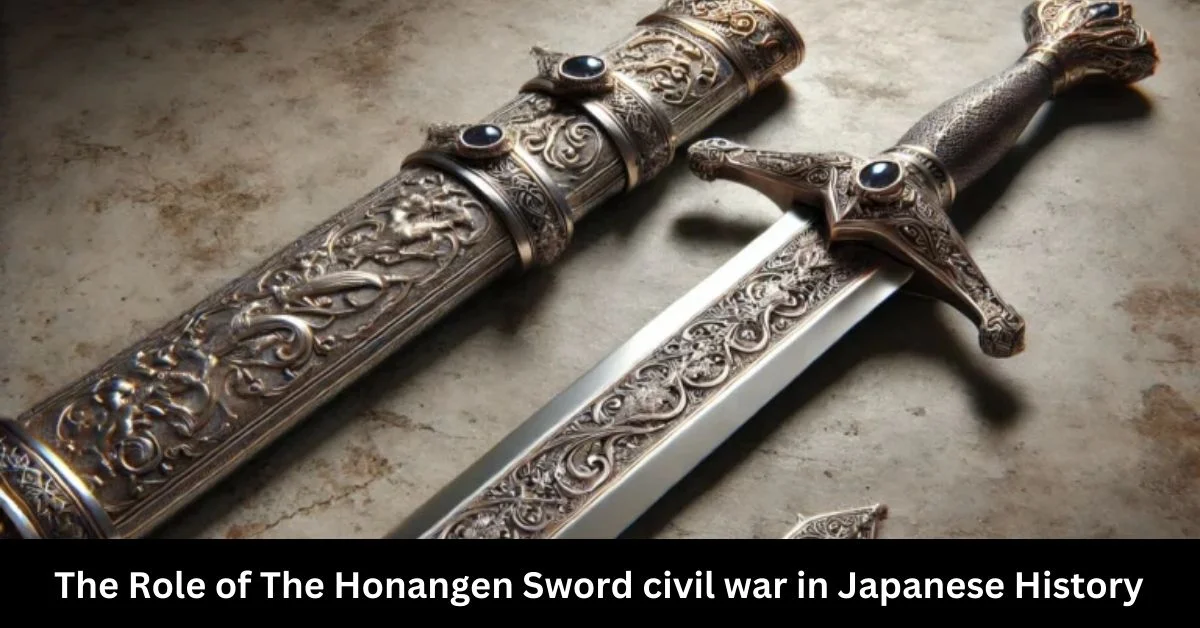Throughout history, symbols have often played a pivotal role in shaping and reflecting the identity and unity of nations. In the case of Japan, swords have always held a profound significance, with the Honangen sword civil war standing out as a particularly important emblem of power, tradition, and continuity. This ancient relic, steeped in legend, played an indirect but crucial role during a time of significant internal strife – the Japanese Civil Wars. This article delves into the rich history of the Honangen sword and its connection to the civil wars that shaped Japan, while examining the broader context of samurai warfare and how this ancient weapon came to represent far more than just a tool of battle.
The Honangen Sword: A Symbol of Imperial Power
The Honangen sword, also referred to as one of the three sacred imperial regalia of Japan, stands as an embodiment of divine authority. The sword is said to have been passed down from the gods themselves, symbolising the divine right of Japan’s emperors to rule the country. Alongside the Yata no Kagami (a mirror) and Yasakani no Magatama (a jewel), the Honangen sword forms the triad of treasures known as the Imperial Regalia of Japan. These items, often steeped in myth and guarded closely by the imperial household, have been central to Japan’s monarchy and the continuity of its dynastic rule for centuries.
The legend of the Honangen sword civil war dates back to the mythological age of Japan, where the sun goddess Amaterasu handed the sword to her grandson Ninigi, who later gave it to the first emperor of Japan, Jimmu. The sword, named Kusanagi no Tsurugi, also has a rich backstory involving its use to slay a monstrous serpent, adding to its mystical aura. Beyond its mythological origins, the Honangen sword has historically been a symbol of political legitimacy. Possession of the sword was believed to confer divine sanction to rule, and it has been handed down through generations of Japanese emperors as an emblem of their sovereignty.
Japan’s Civil Wars: A Period of Unrest
Japan’s history is marked by periods of intense internal conflict, often driven by the competing ambitions of powerful warlords, or daimyo, who vied for control of the country. The most notable of these internal struggles were the Sengoku Period (1467-1603) and the Genpei War (1180-1185), which significantly reshaped the political landscape of Japan.
The Sengoku Period
The Sengoku Period, also known as the “Warring States Period,” was a time of nearly constant warfare between rival daimyo. After the weakening of the central government under the Ashikaga shogunate, regional warlords sought to expand their territories and consolidate power. Samurai clans led by ambitious military commanders, such as Oda Nobunaga, Toyotomi Hideyoshi, and Tokugawa Ieyasu, engaged in a series of bloody conflicts that eventually resulted in the unification of Japan under the Tokugawa shogunate in the early 17th century.
The Honangen sword, though not a direct player in the battles of the Sengoku period, stood as a reminder of the legitimate power held by the emperor, even as the actual political control slipped from the imperial family’s grasp into the hands of the military rulers, or shoguns. Despite the emperor’s limited direct involvement in these wars, the symbolic importance of the sword remained intact, a relic of a time when imperial authority was unchallenged.
The Genpei War
The Genpei War, another significant conflict in Japanese history, was fought between two powerful clans, the Taira and the Minamoto, from 1180 to 1185. This war marked the end of the Heian period and the beginning of the Kamakura shogunate. The Honangen sword’s legacy during this period is especially notable because the sword is said to have been lost at sea during the Battle of Dan-no-ura in 1185, when the Taira clan, fleeing the Minamoto forces, attempted to escape by boat. According to legend, the young Emperor Antoku, who was aboard the ship, jumped into the water with the Honangen sword, and both were lost to the sea.
The loss of the sword during the Genpei War was a profound symbolic blow to the imperial family and Japan as a whole. Yet, stories suggest that the sword was later recovered by divers, and its continued existence ensured that it remained a potent emblem of imperial continuity.
Also Read: Monetize Your Content with WWW FameBlogsNet
Samurai and the Sword: The Iconography of War
No discussion of Japan’s civil wars can be complete without a focus on the samurai, the warrior class that dominated the country’s military and political landscape for centuries. Samurai were not merely soldiers; they were the embodiment of a strict code of honour known as bushido, or “the way of the warrior,” which emphasised loyalty, discipline, and martial skill. Central to their identity was the sword, which came to represent the soul of the samurai.
The Honangen sword, as a legendary artefact, transcended the role of a mere weapon. It represented the ultimate expression of power and legitimacy, far beyond the swords carried by individual samurai. While many samurai wielded finely crafted katana, the Honangen sword, as part of the imperial regalia, became a symbol that every warrior revered. The sword was not just a weapon of war but a cultural and spiritual artefact, linking the samurai’s martial prowess to the divine authority of the emperor.
During periods of civil war, particularly in the Sengoku era, when the emperor’s role was largely ceremonial, the Honangen sword’s significance as a symbol of continuity remained a powerful ideological tool. While the shoguns ruled in practice, the sword ensured that the emperor maintained his place at the heart of Japan’s cultural and political identity.
The Honangen Sword in the Tokugawa Shogunate
The Tokugawa shogunate, established by Tokugawa Ieyasu in 1603, ushered in a period of relative peace known as the Edo Period. Under Tokugawa rule, Japan saw an end to the near-constant warring of the Sengoku Period, as the shogunate centralised power and imposed strict control over the daimyo and their samurai armies. Despite the shift in power from the emperor to the shogun, the Honangen sword continued to play a critical role in maintaining the symbolic authority of the imperial family.
Tokugawa Ieyasu was keenly aware of the importance of the emperor’s legitimacy, even as he consolidated real political power for himself. The shogunate maintained a careful balance, ensuring that the emperor retained his symbolic role, which was important for the spiritual and cultural unity of Japan. The Honangen sword civil war, along with the other items of the imperial regalia, served as a reminder that, while the shogun held military control, it was the emperor who remained the spiritual and cultural leader of the nation.
Honangen Sword and the Meiji Restoration
By the mid-19th century, Japan faced a new set of challenges with the arrival of Western powers and the increasing pressure to open its borders to international trade. The internal dissatisfaction with the Tokugawa shogunate, combined with the external pressures from Western countries, led to the Meiji Restoration in 1868. This period marked the restoration of imperial rule under Emperor Meiji and the dismantling of the shogunate system that had dominated Japan for over 250 years.
The Meiji Restoration was a time of profound change for Japan, as the country sought to modernise its institutions, military, and economy in order to compete with the rising industrial powers of the West. During this time, the Honangen sword once again took on a renewed significance as a symbol of the emperor’s restored power. As Japan transitioned from a feudal system dominated by the samurai to a modern nation-state, the imperial regalia, including the Honangen sword, were used to legitimise the new political order.
In the modern era, the Honangen sword remains an important part of the imperial enthronement ceremonies. Though its exact location and appearance are shrouded in mystery, the sword’s symbolic value as a representation of the emperor’s divine right to rule remains undiminished.
The Role of the Honangen Sword in Japanese Culture
Beyond its historical and political significance, the Honangen sword occupies a special place in Japanese culture. It is not only a symbol of imperial power but also a representation of the virtues of the samurai class, including honour, courage, and loyalty. In many ways, the sword has become a symbol of Japan itself – a country that values tradition, continuity, and resilience.
In Japanese literature and art, swords often play central roles in stories of heroism and tragedy. The Honangen sword civil war, with its legendary origins and association with the gods, is frequently invoked in such tales. It serves as a reminder of the close connection between the emperor, the divine, and the Japanese people.
Moreover, the sword’s legacy is intertwined with the notion of the kokutai, or the national essence of Japan. During the years leading up to World War II, the imperial regalia, including the Honangen sword, were used to promote the idea of Japan’s uniqueness and the divinely ordained nature of its emperor. While Japan has since moved away from these militaristic and nationalistic ideologies, the cultural significance of the Honangen sword remains a powerful reminder of the country’s deep historical roots.
Conclusion
The Honangen sword civil war, as an anchor to Japan’s imperial heritage, has played a subtle but enduring role throughout the country’s turbulent history. From the mythical age of gods to the bloody civil wars of the Sengoku and Genpei periods, and through the political shifts of the Tokugawa shogunate and the Meiji Restoration, this sacred sword has represented more than just the power of an individual ruler. It stands as a testament to the enduring legacy of the Japanese emperor and the continuity of the nation’s cultural and spiritual traditions.
While its role in battle may have been largely symbolic, the Honangen sword remains a powerful emblem of authority and unity in Japan. Its presence during key historical moments reminds us that, in times of war and peace, symbols like the Honangen sword hold the power to shape nations, inspire loyalty, and preserve a sense of identity through the ages.
Read More: Canine Handler NYT Crossword: Skills, Training, and Career Paths






